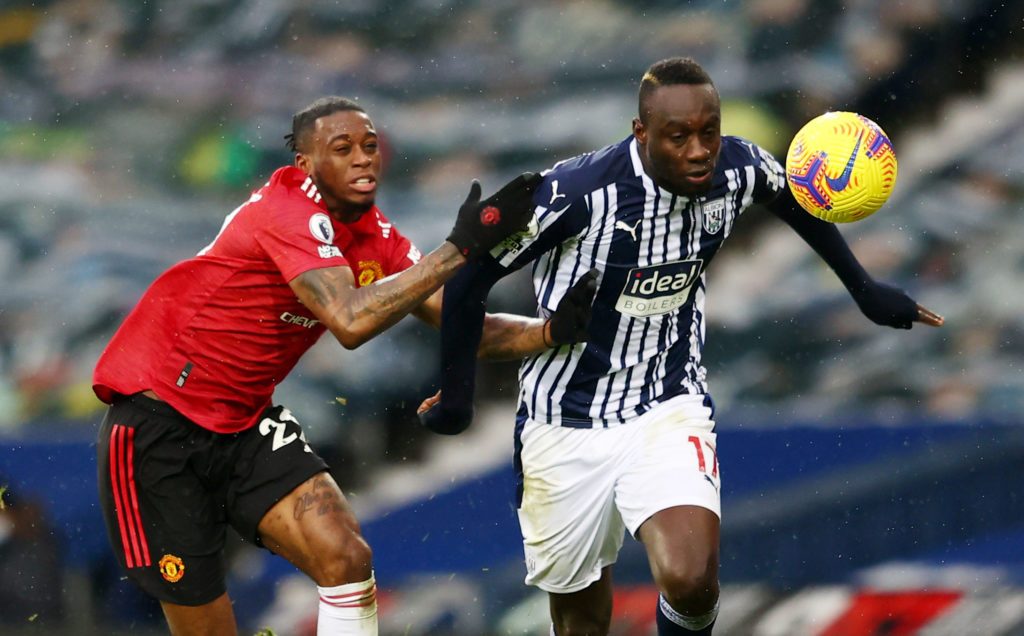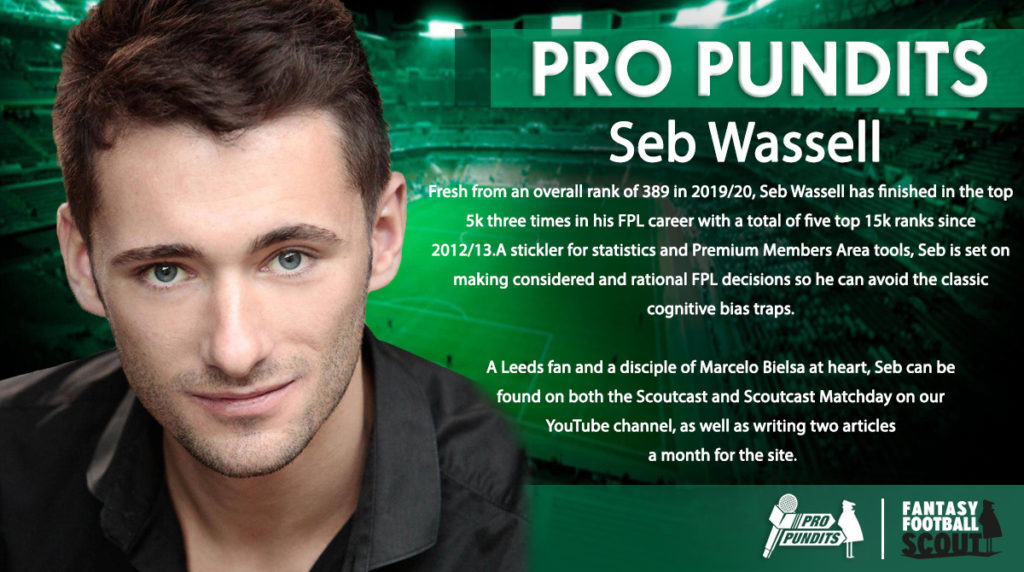Three-time top 5k finisher Seb Wassell reveals his thoughts as Fantasy Premier League managers prepare for a busy run-in to the 2020/21 season.
‘Us vs. Them’, ‘Yorkshire vs. Lancashire’, ‘Stats vs The Eye Test’. Timeless, tribal debates that see passionate supporters and detractors on both sides. But one of these is not like the others.
Here I will make the case for ‘Stats vs. The Eye Test’ being a false dichotomy and why, at this time of Double Gameweeks, Wildcards and crunch decision-making, anyone that finds themselves exclusively on one side or the other – or even believes there are sides to this debate in the first place – is never going to achieve the Fantasy Premier League success we all crave.
Eye of the Beholder

We are instinctively inclined to believe our own eyes over almost all other information. This is a primal bias that is extremely difficult to identify let alone overcome. Seeing is believing after all.
When it comes to football, many believe there is no substitute for watching matches. Football is meant to be experienced, it is meant to be enjoyed, those rare moments of complete brilliance, total anguish and overwhelming joy are what it is all about. If you do not watch football, you do not get football, and this goes doubly for the Fantasy game, right? Stats fly in the face of that. They often reduce our favourite moments to “luck” and describe impossible feats as “variance”. How can you “expect” a goal? Can you quantify “desire”? Frankly, they are all work and no play.
However, there is often a large disparity between what we see and what is empirically true. For a non-football example, take “the dress”. For those unaware, a photograph of a dress was posted on social media in 2015 that for millions appeared quite clearly to be white and gold. However, an equally large and convinced group of people were adamant it was black and blue. I will avoid spoiling it here if you have not already experienced it, but needless-to-say it was confirmed to be only one of these colour combinations, with the other theorised to be a result of presentation, our own personal perceptions, previous experiences with lighting and existing expectations.
In this same way, what we see on a football pitch can be misleading, incomplete and sometimes even harm our ability to make the best decisions. And yet, some of the best fantasy managers proudly consume huge amounts of football each week.
Numbers Don’t Lie

By contrast, a growing number of the football community, and more specifically the Fantasy Premier League community, are becoming literate in stats. Contrary to the belief of some, the world of football statistics was not dreamt up by anti-football, calculus-wielding mathematicians. Quite the opposite in fact.
I like to imagine that Expected Goals (xG) was the result of a late night, post-match argument over whether a striker “should have scored”, as is so often the commentary rhetoric. Two people that see the same event can differ on its interpretation. Stats allow us to lend objectivity to this argument.
In the case of xG, we can reference any single shot against a huge backlog of similar shots and conclude with a good degree of reliability how often that particular opportunity results in a goal. So “should have scored” becomes “50% of the time, that is a goal”. This does not mean that a 50% chance that was missed in the last match will be scored in the next, the probabilities are independent to one another, but it does start to give us a useful quantitative tool to describe how likely a unique event is to result in a certain outcome.
Rather than being separate or contradictory to the eye test, stats are there to help us process what we are seeing and, crucially, allow us to begin to predict future events. FPL is a game of predictions and the more tools we have at our disposal to do this accurately, the better we will be for it.
However, stats can also mislead us. Knowing that a team had 33% possession and three shots in a match sounds disastrous, but if we also know that this team scored two very early goals against stronger opposition and then determined to sit deep, soak up pressure and attempt to see the match out – meaning their possession and shot numbers were intentionally culled – we begin to understand the context of those numbers.
Often, we see a player praised for a huge number of completed passes, but if none of those passes progressed the ball up the pitch, is that as impressive? Just as with the eye test, we need to know what to pay attention to and what to disregard, how to view stats within their context and how to act on them without bias.
An Evidence Based Approach

The truth is that both stats and the eye test are attempting to describe the same thing: a football match. This is the scientific method, where we observe, analyse and then draw evidence-based conclusions. Whilst they may appear in competition with one another, there are no statisticians worth their spreadsheets nor football fans worth their season tickets that do not understand one through the prism of the other.
No successful football club will sign a player without having watched them play, but the way they identify which players to watch are by trawling the stats of thousands first.
Stats are to football what air travel is to transportation: wanting to get from A to B but better than before. They are a natural evolution of watching and analysing football, born from the desire to quantify what is happening on a football pitch in a more comprehensive, objective, memorable and comparable fashion. Stats do not compete with the eye test, they are simply the eye test presented as objective, reliable data.
It is extremely difficult to remember every action a single player took during a 90-minute match, let alone what the other 21 did. Expand this then to a full season and the eye test alone cannot possibly hope to give you what you need. A shot on target is a shot on target whether I watch it happen and assign it to memory or read about it later in the Premium Members’ Area. The difference is that there is only so much I can do with that memory, and memories get distorted (see the Mandela Effect, where a large group of people independently remember an event to have occurred differently to how it actually occurred, or even remember something that never happened in the first place). Stats allow us to preserve this information and use it without distortion later.
This is not to say that stats are perfect, they are a work in progress. Some of them are still frustratingly reliant on human input, such as ‘big chances’, which is manually judged by a human at Opta rather than being the result of a chance exceeding a specific xG value.

If we know this though, we can use it to our advantage. We can combine stats and the watching of matches to give us the fullest picture possible, correct to the weight we personally place in one action over another.
The majority of stats focus on defined, finite actions, whereas a favourite of Fantasy managers is thinking “what if”. For example, xG only records shots taken. A player through on goal that does not pull the trigger before the ball is smothered by the goalkeeper is not recorded as a shot and so has no xG. However, we know that this was in fact a very good opportunity to score. Combine both these pieces of information and you have an edge.
Ultimately, it is evidence that we are looking for. Evidence free of bias most importantly. The eye test is wide open to biases – confirmation bias, recency bias, the availability heuristic, being reliant on Match of the Day showing you everything you need to know in 10 minutes as opposed to selecting your own samples – but then so are stats, we have all scrolled through tables looking for that magic number that backs up the transfer we wanted to make anyway. The key is knowing how and when to use each tool we have at our disposal. The best fantasy managers can identify essential information and act upon it, but they will always use multiple methods for this.
Consider a scenario borrowed from Neil deGrasse Tyson: You are walking your dog, it zig-zags side-to-side on the lead, but overall moves forwards in the direction you are walking it. While the zigs and zags are hard to predict, the general direction of movement is not. “Lucky” managers may catch some of the zigs and zags, “skilful” managers know it is the overall picture we need.
Both methods of analysis can fall prey to this, we may put too much emphasis on the events we see live or prioritise only recent data. It is sensible interpretation with given context that allows us to operate with skill rather than luck.
Bear in mind also that information is only as good as the source it is from. Naturally, we want to identify trends as soon as possible, but realistically this is only reliable over the course of months, if not years, of matches. This is where some of those intangibles mentioned earlier may creep into our thinking, trying to explain what is in fact simply variance.
My favourite recent example of the two methods not being two separate methods at all but in fact dovetailing beautifully is Tottenham. Spurs’ early season results were excellent, both from a fantasy and real-life perspective, yet they now languish in ninth place. Could we have predicted this? Can we identify what might happen in the future?

We know that, for example, Son Heung-min (£9.5m) is a traditionally excellent finisher and thrives on the counter. We can see this when watching him and it is backed up by the stats. We also know that he receives a disproportionately high number of big chances, something else that is evidenced by both our eyes and the numbers.
Naturally, big chances have a higher conversion rate than small chances. Early in the season, Spurs were performing well above their xG and Son was benefitting handsomely. There were a number of factors involved in this, from luck to style of play.
Under Jose Mourinho, Tottenham had a tendency to attack early in a match, looking to secure a lead and then defend it from there. Due to this and the opposition they were facing, a number of these chances came on breaks into space. With Son drifting centrally from the left and Harry Kane (£11.1m) dropping off to supply him, we saw the forward presented with plenty of opportunities to convert the types of chances that suit him perfectly. As the season has progressed however, this has diminished, both through the absence of opportunity and a regression to their mean xG. They could not continue to score with their first (and sometimes only) few shots of a match against opposition that knew this was coming, we know this both instinctively and through historical data, nor did they adapt in a way that attempted to combat that. It is in this way that we could both understand what was happening with Spurs and predict how likely it was to continue. Similarly, with many now turning to Harry Kane again ahead of gameweek 26, we see both stats tables and tactical shifts being referenced as strong evidence for selecting him. I will leave that debate to our other Pro Pundits though!
Whether you prefer to consume your football in the stands or on a spreadsheet, we are all trying to do the same thing; understand what is happening, analyse why it is happening and predict what might happen in the future. For anyone that believes there is only one way to do this, I urge you to reconsider. What you are really doing is shutting yourself off from half of the information you need in order to make successful Fantasy Premier League decisions. And if you believe the eye test is the best way to judge football, I humbly suggest that you are effectively trying to get from A to B on horseback whilst everyone else has a plane ticket. Eventually, every event on a football pitch may be fully covered by stats. For now, however, we need both. Follow those stats to confirm what your eyes are seeing but keep watching matches to ensure you have context and, most importantly of all, to keep football and Fantasy Premier League fun.





3 years, 1 month agoQual and quant ftw